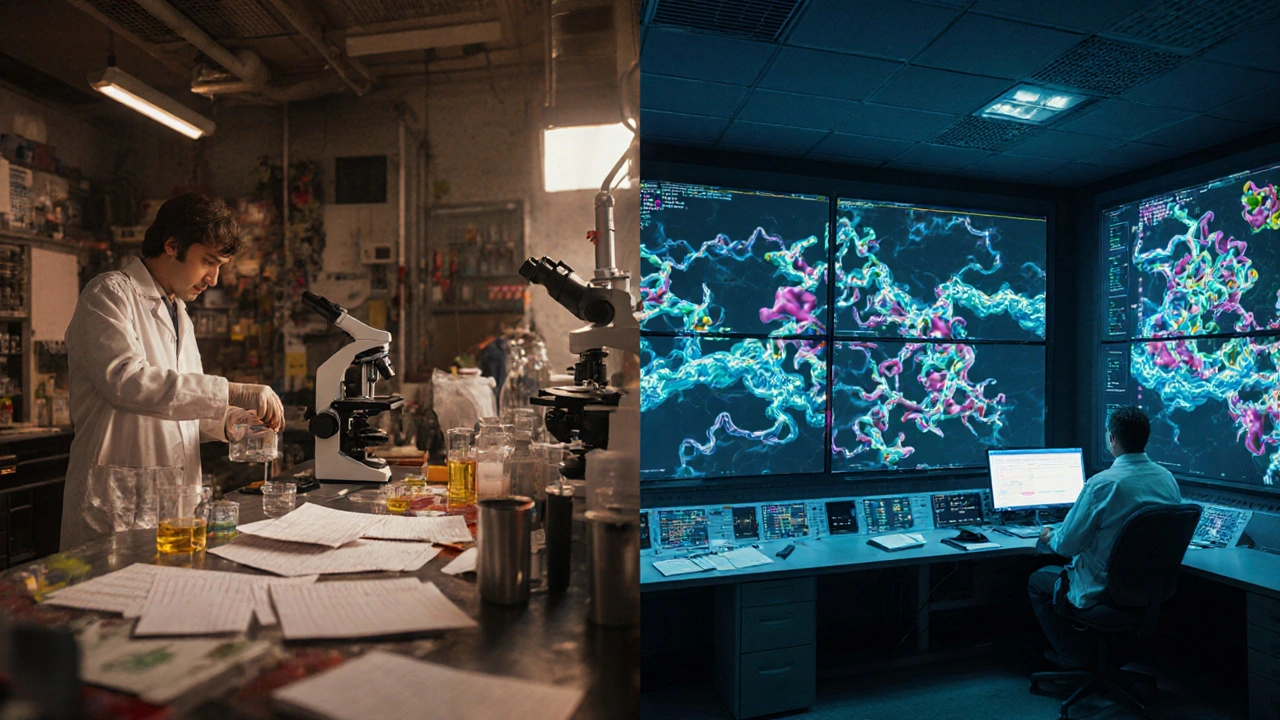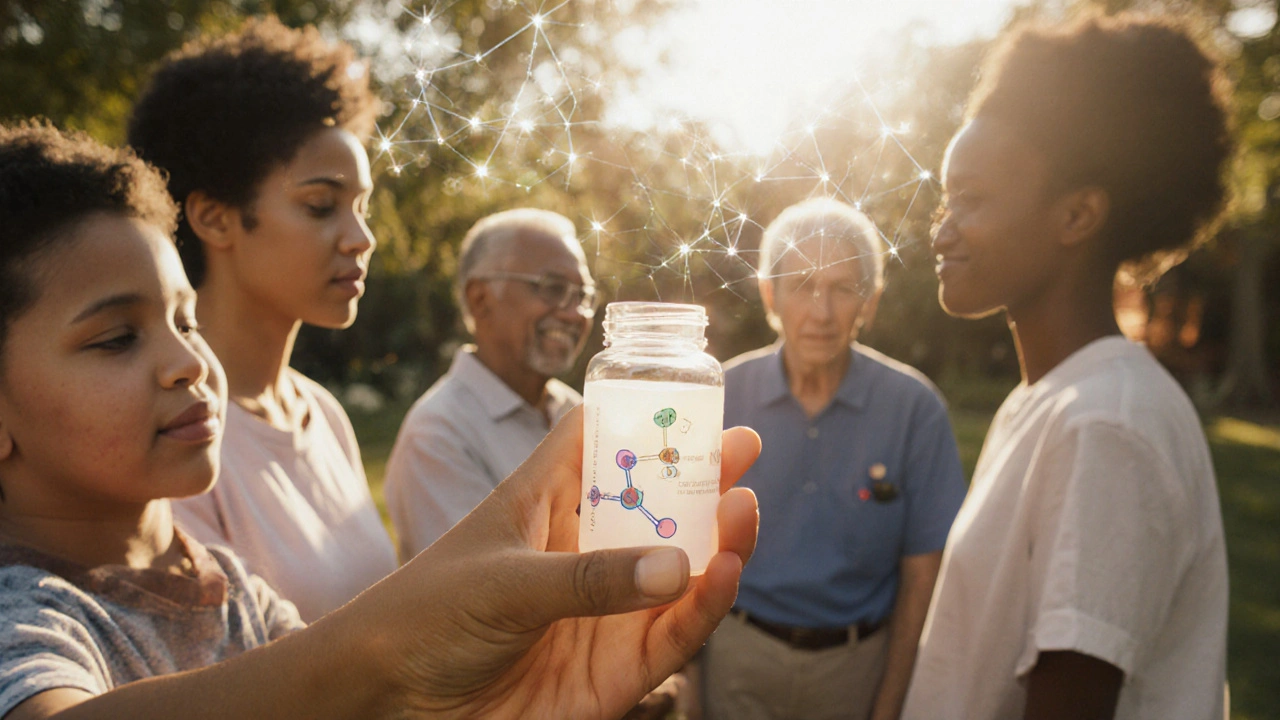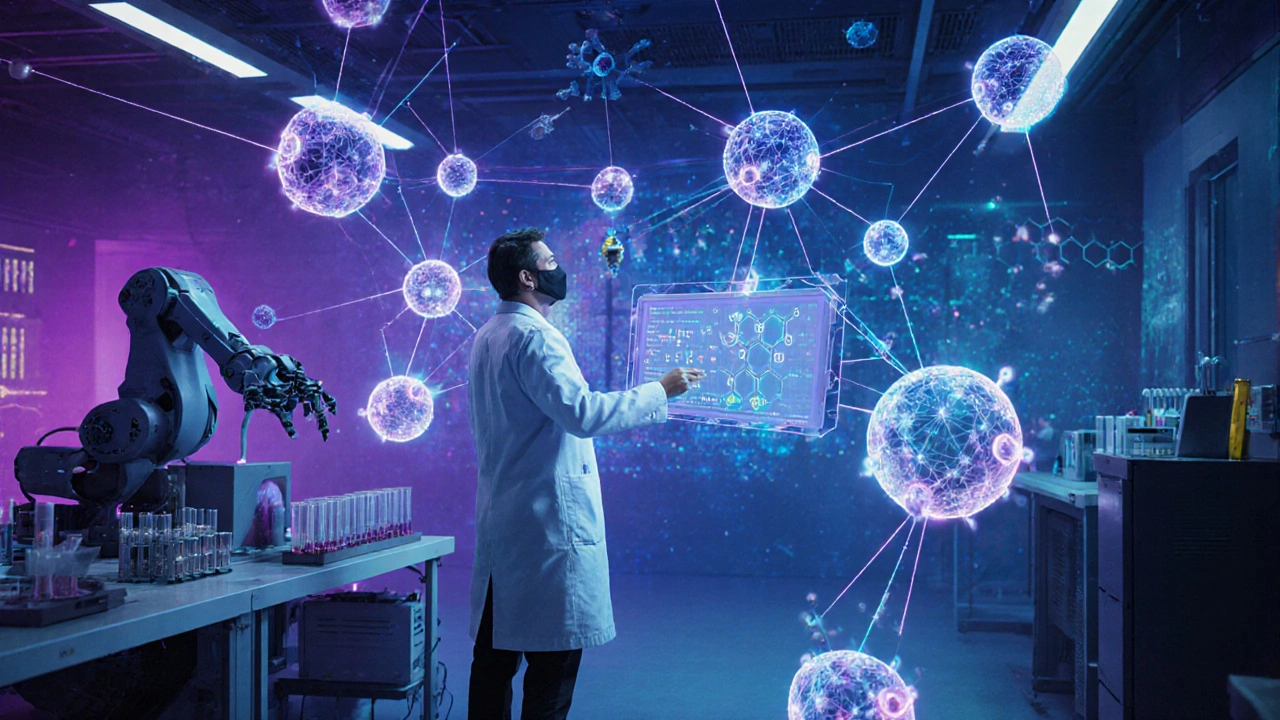Drug Discovery Cost & Time Estimator
How AI is transforming drug discovery
According to the article, traditional drug discovery costs over $2.6 billion and takes more than 10 years with a 90% failure rate. AI-driven approaches can reduce costs by 30-50% and development time by half, while increasing Phase I success rates by 40%.
AI-Driven Drug Discovery
For decades, finding a new drug meant years of trial and error. Scientists tested thousands of compounds, watched for side effects, and waited months just to see if one molecule might work. The average cost? Over $2.6 billion. The average time? More than 10 years. And more than 90% of candidates failed before reaching patients. That’s not just slow-it’s broken.
Now, AI is changing that. Not as a magic wand, but as a precision tool that cuts through noise and finds patterns humans miss. Companies like Insilico Medicine and DeepMind have already used AI to design novel molecules in weeks instead of years. In 2023, a team at Stanford trained an AI model to predict how a drug binds to a protein with 95% accuracy-outperforming traditional methods by nearly 40%. This isn’t science fiction. It’s happening now.
Why Traditional Drug Discovery Fails
Drug discovery starts with a target-a protein or gene linked to a disease. Then comes screening: testing millions of chemical compounds to see which ones interact with that target. Most of them don’t. The ones that do often fail later because they’re toxic, don’t absorb well in the body, or break down too fast.
The problem isn’t just scale-it’s complexity. A single molecule can have billions of possible shapes. Each shape interacts differently with human biology. Traditional methods rely on guesswork, intuition, and slow lab tests. Even the best scientists can’t mentally model all those interactions.
That’s where AI steps in. Instead of testing one compound at a time, AI models can simulate millions of molecular interactions in seconds. They learn from decades of published research, clinical trial data, and failed experiments. They don’t get tired. They don’t ignore outliers. They find hidden connections.
How AI Actually Works in Drug Discovery
AI doesn’t replace chemists. It gives them superpowers. Here’s how it works in practice:
- Target identification: AI scans genetic databases, patient records, and protein structures to find the most promising disease targets. For example, in Alzheimer’s research, AI identified a previously overlooked protein linked to plaque buildup-something 30 years of human analysis missed.
- Molecule generation: Generative AI models create new chemical structures designed to fit specific targets. In 2024, Insilico Medicine used this method to design a new fibrosis drug in just 46 days. The same process would have taken a team of 50 scientists over two years.
- Predicting properties: AI predicts whether a molecule will be absorbed by the gut, pass through the blood-brain barrier, or cause liver damage. These are the exact reasons 80% of drugs fail in early trials. AI catches them before a single test tube is filled.
- Repurposing old drugs: AI looks at existing FDA-approved drugs and finds new uses. A diabetes drug called metformin, for instance, was flagged by AI as potentially effective against lung cancer. Clinical trials are now underway.
Each step reduces guesswork. Each step saves time. And each step cuts costs.
Real-World Success Stories
It’s easy to talk about AI in theory. But here’s what’s already working:
- Insilico Medicine’s ISM001-055: This was the first AI-designed drug to enter human trials without human-designed starting points. It was created entirely by AI in 2022. By 2024, it was in Phase II trials for idiopathic pulmonary fibrosis. No animal testing was used in the initial design phase.
- Exscientia’s DSP-1181: Designed by AI for obsessive-compulsive disorder, this drug reached clinical testing in 12 months-half the industry average. It’s now in Phase I trials with promising safety data.
- Google DeepMind’s AlphaFold: While not a drug itself, AlphaFold solved the 50-year-old protein folding problem. Before this, predicting a protein’s 3D shape took months. Now, AI does it in minutes. That alone has accelerated target identification across hundreds of diseases.
These aren’t outliers. They’re proof of a new system. Companies using AI in drug discovery now have a 40% higher success rate in Phase I trials compared to traditional approaches, according to a 2025 report by McKinsey.

What AI Can’t Do (Yet)
AI isn’t perfect. It still needs humans.
AI can’t yet understand the full complexity of human biology. A molecule might bind perfectly to a protein in a simulation, but trigger an immune reaction in a real patient. AI doesn’t know what it doesn’t know. That’s why human experts still validate every finding.
Also, AI models are only as good as their data. If the training data is biased-say, mostly from white, male populations-then the drugs designed might not work as well for women or people of color. That’s a real risk. Some AI tools are already being audited for bias in drug response predictions.
And regulatory agencies like the FDA are still catching up. Until recently, there were no clear guidelines for approving AI-designed drugs. In 2024, the FDA released its first framework for evaluating AI in drug development. It’s a start, but not a finish.
The Future: Faster, Cheaper, Personalized
The next frontier isn’t just finding drugs faster. It’s finding the right drug for the right person.
AI is already being used to match patients to drugs based on their genetics, lifestyle, and medical history. In cancer treatment, AI analyzes tumor DNA and recommends combinations of drugs that are most likely to work. One trial in Melbourne showed AI-guided treatment doubled survival rates for patients with rare lung cancers.
By 2030, experts predict AI will cut drug development time by half and reduce costs by 30-50%. That could mean new treatments for rare diseases that were too expensive to pursue before. Think of conditions like Huntington’s disease or ALS-conditions with tiny patient pools. Pharma companies ignored them because the math didn’t add up. AI changes that math.
Imagine a world where a child is diagnosed with a genetic disorder, and within 30 days, a custom-designed drug is being tested in a lab. That’s not a dream. It’s the direction we’re moving.

What This Means for Patients
For patients, this isn’t just about speed. It’s about hope.
People with rare diseases often wait decades for any treatment. Cancer patients run out of options. Chronic illness sufferers live with pain because the drugs available are too blunt, too toxic, too ineffective.
AI doesn’t guarantee cures. But it guarantees more chances. More options. More targeted therapies. Less wasted time. Less suffering from side effects.
And it’s not just for the wealthy. As AI drives down costs, these drugs could become more affordable. Generic versions of AI-designed drugs could emerge faster, because the R&D burden is lighter.
One of the biggest shifts? The focus is moving from treating symptoms to preventing disease before it starts. AI can predict who’s likely to develop Alzheimer’s years before symptoms appear-and then design a drug to stop it.
Where to Watch Next
Keep an eye on these developments:
- AI + robotics labs: Companies like Emerald Cloud Lab are building fully automated labs where AI designs a drug, orders chemicals, runs tests, and analyzes results-all without human hands.
- Open-source AI models: Projects like OpenFold and ChemBERTa are making AI tools free for researchers worldwide. This levels the playing field for small labs and universities.
- Regulatory progress: The EU and U.S. are working on shared standards for AI drug approval. That will speed up global access.
Don’t expect AI to replace scientists. But expect them to work side by side-with AI handling the impossible math, and humans bringing ethics, creativity, and care.
Can AI really design a drug without human input?
Yes, but it’s rare. Insilico Medicine’s ISM001-055 was the first drug designed entirely by AI, from target selection to molecular structure. However, humans still oversee the process, validate results, and guide the AI’s goals. AI doesn’t think-it calculates. Humans decide what’s worth calculating.
Are AI-designed drugs safer than traditional ones?
They can be. AI models predict toxicity and side effects before a drug is even made. That means fewer dangerous compounds reach clinical trials. Early data shows AI-designed drugs have lower failure rates in Phase I due to safety issues. But long-term data is still being collected. All drugs, AI-made or not, must pass the same rigorous safety standards.
Why aren’t all drug companies using AI yet?
Cost, culture, and complexity. Building or buying AI tools requires investment and expertise. Many pharma companies still rely on legacy systems and teams trained in traditional methods. There’s also fear-of losing control, of making mistakes, of regulatory uncertainty. But the leaders are already seeing results. The ones holding back are starting to fall behind.
How long until AI-designed drugs are common?
They’re already here. Five AI-designed drugs are in clinical trials as of 2025. The first one could be approved by late 2026. Within five years, 20-30% of new drug candidates could be AI-designed. By 2035, most major pharmaceutical companies will rely on AI for at least half their pipeline.
Does AI make drug development less ethical?
It can-if used poorly. If AI is trained on biased data, it might design drugs that work better for certain groups and not others. If companies use AI to rush drugs to market without proper testing, risks increase. But AI can also make drug development more ethical: by reducing animal testing, speeding up treatments for neglected diseases, and lowering costs so more people can access medicine. The ethics depend on how we build and use it.

